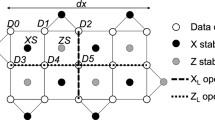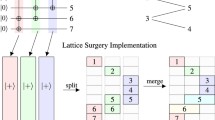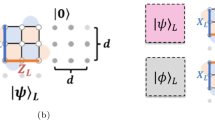Abstract
The lattice surgery approach allows for an efficient implementation of universal quantum gate sets with topological quantum error correcting codes that achieve a high threshold and are composed of only the nearest gate operations and low-weight stabilizers. Here, we propose two types of lattice surgery-based logical qubit architectures using the logical remote-controlled-not operation and circuit mapping method. Our architectures enhanced the qubit efficiency, and when combined with our qubit initialization and routing process, they reduced the running time and quantum volume of several quantum circuits by removing time-expensive logical SWAP operations and enabling fast logical CNOT operations. The quantum volume was compared between three cases, one in which the magic state distillation technique was not applied, one in which the multiple magic state distillation circuits are used to reduce the circuit execution time, and the other in which one magic state distillation circuit are used to reduce the number of qubit used.















Similar content being viewed by others
Data Availability
The datasets generated during and/or analyzed during the current study are available from the corresponding author on reasonable request.
References
Arute, F., Arya, K., Babbush, R., Bacon, D., Bardin, J.C., Barends, R., Biswas, R., Boixo, S., Brandao, F.G., Buell, D.A., et al.: Quantum supremacy using a programmable superconducting processor. Nature 574(7779), 505–510 (2019)
IBM Quantum Experience. https://quantum-computing.ibm.com/
Shor, P.W.: Algorithms for quantum computation: discrete logarithms and factoring. In: Proceedings 35th Annual Symposium on Foundations of Computer Science, pp. 124–134 (1994). Ieee
Grover, L.K.: A fast quantum mechanical algorithm for database search. In: Proceedings of the Twenty-eighth Annual ACM Symposium on Theory of Computing, pp. 212–219 (1996)
Multiple-particle interference and quantum error correction. Proceedings of the Royal Society of London. Series A: Mathematical, Physical and Engineering Sciences 452(1954), 2551–2577 (1996). https://doi.org/10.1098/rspa.1996.0136
Shor, P.W.: Scheme for reducing decoherence in quantum computer memory. Physical Review A 52(4) (1995). https://doi.org/10.1103/physreva.52.r2493
Steane, Am.: Quantum reed-muller codes. IEEE Transactions on Information Theory 45(5), 1701–1703 (1999). https://doi.org/10.1109/18.771249
Kitaev, A.Y.: Fault-tolerant quantum computation by anyons. Annals of Physics 303(1), 2–30 (2003)
Bravyi, S.B., Kitaev, A.Y.: Quantum codes on a lattice with boundary. arXiv preprint arXiv:quant-ph/9811052 (1998)
Bombin, H., Martin-Delgado, M.A.: Topological quantum distillation. Physical review letters 97(18), 180501 (2006)
Versluis, R., Poletto, S., Khammassi, N., Tarasinski, B., Haider, N., Michalak, D.J., Bruno, A., Bertels, K., DiCarlo, L.: Scalable quantum circuit and control for a superconducting surface code. Physical Review Applied 8(3), 034021 (2017)
Jones, C., Fogarty, M.A., Morello, A., Gyure, M.F., Dzurak, A.S., Ladd, T.D.: Logical qubit in a linear array of semiconductor quantum dots. Physical Review X 8(2), 021058 (2018)
Fowler, A.G., Mariantoni, M., Martinis, J.M., Cleland, A.N.: Surface codes: Towards practical large-scale quantum computation. Physical Review A 86(3), 032324 (2012)
Horsman, C., Fowler, A.G., Devitt, S., Van Meter, R.: Surface code quantum computing by lattice surgery. New Journal of Physics 14(12), 123011 (2012)
Hwang, Y., Kim, T., Baek, C., Choi, B.-S.: Integrated analysis of performance and resources in large-scale quantum computing. Physical Review Applied 13(5), 054033 (2020)
Fowler, A.G., Gidney, C.: Low overhead quantum computation using lattice surgery. arXiv preprint arXiv:1808.06709 (2018)
Lao, L., van Wee, B., Ashraf, I., van Someren, J., Khammassi, N., Bertels, K., Almudever, C.G.: Mapping of lattice surgery-based quantum circuits on surface code architectures. Quantum Science and Technology 4(1), 015005 (2018)
Litinski, D.: A game of surface codes: Large-scale quantum computing with lattice surgery. Quantum 3, 128 (2019)
Chamberland, C., Campbell, E.T.: Universal quantum computing with twist-free and temporally encoded lattice surgery. arXiv preprint arXiv:2109.02746 (2021)
Nielsen, M.A., Chuang, I.: Quantum computation and quantum information. American Association of Physics Teachers (2002)
Bravyi, S., Kitaev, A.: Universal quantum computation with ideal clifford gates and noisy ancillas. Physical Review A 71(2), 022316 (2005)
Bravyi, S., Haah, J.: Magic-state distillation with low overhead. Physical Review A 86(5), 052329 (2012)
Brown, B.J., Laubscher, K., Kesselring, M.S., Wootton, J.R.: Poking holes and cutting corners to achieve clifford gates with the surface code. Physical Review X 7(2), 021029 (2017)
Herr, D., Nori, F., Devitt, S.J.: Lattice surgery translation for quantum computation. New Journal of Physics 19(1), 013034 (2017)
Dousti, M.J., Shafaei, A., Pedram, M.: Squash: a scalable quantum mapper considering ancilla sharing. In: Proceedings of the 24th Edition of the Great Lakes Symposium on VLSI, pp. 117–122 (2014)
Cuccaro, S.A., Draper, T.G., Kutin, S.A., Moulton, D.P.: A new quantum ripple-carry addition circuit. arXiv preprint arXiv:quant-ph/0410184 (2004)
Draper, T.G.: Addition on a quantum computer. arXiv preprint arXiv:quant-ph/0008033 (2000)
Acknowledgements
This work was supported by Institute for Information & communications Technology Planning & Evaluation (IITP) grant funded by the Korea government (MSIT) [No. 2020-0-00014, A Technology Development of Quantum OS for Fault-tolerant Logical Qubit Computing Environment] This work was supported by the ICT R &D program of MSIT/IITP. [IITP-2022-2021-0-01810, Development of elemental technologies for Ultra-secure Quantum Internet.]
Author information
Authors and Affiliations
Corresponding author
Additional information
Publisher's Note
Springer Nature remains neutral with regard to jurisdictional claims in published maps and institutional affiliations.
Appendix A: Logical CNOT operation in r-arch
Appendix A: Logical CNOT operation in r-arch
CNOT operation for the control and target logical qubits in the same row. a Control qubit \(\vert C \rangle _L\), the target qubit \(\vert T \rangle _L\), and two intermediate qubits \(\vert INT_1 \rangle _L\) and \(\vert INT_2 \rangle _L\) are prepared. Intermediate qubits are in \(\vert + \rangle _L\) states. Merge \(\vert C \rangle _L\) and \(\vert INT_1 \rangle _L\). Merge \(\vert T \rangle _L\) and \(\vert INT_2 \rangle _L\) at the same time. b \(\vert C_1 \rangle _L\) and \(\vert T_1 \rangle _L\) is the merged state. Split \(\vert C_1 \rangle _L\) by X measurements on green colored qubits c \(\vert C_2 \rangle _L\) and \(\vert INT_1' \rangle _L\) are the split states. Merge \(\vert INT_1' \rangle _L\) and \(\vert T_2 \rangle _L\). d \(\vert T_3 \rangle _L\) is the merged state. X measurement on green-colored qubits and Z measurements on red-colored qubits to reduce the logical qubit size. e State after the physical X and Z measurement \(\vert T_4 \rangle _L\). Prepare a red physical qubit in the \(\vert + \rangle \) state and perform stabilizer measurements. f The stabilizer changes to \(\vert T_5 \rangle _L\). Perform X measurements on green-colored qubits to shrink the qubit size g State after CNOT operation. Steps (d)–(f) steps can be performed over d cycles (Color figure online)
In Sect. 3.2, we briefly explain the CNOT operation when the control and target qubits are in the same row. This appendix exhibits how this CNOT operation is performed. The logical states in Fig. 16 are transformed as follows.
The control logical qubit is denoted as \(\vert C \rangle _L = \alpha \vert 0 \rangle _L+\beta \vert 1 \rangle _L\), the target logical qubit as \(\vert T \rangle _L = a\vert 0 \rangle _L+b \vert 1 \rangle _L\), and the two intermediate logical qubits as \(\vert INT_1 \rangle _L\) and \(\vert INT_2 \rangle _L\). Intermediate qubits were prepared in \(\vert + \rangle _L\) states (Fig. 16a).
From Eq. 2, the post-merged states in Fig. 16b are
where \(X_{L_1} (X_{L_2})\) is equal to \(X_C X_{I_1} (X_T X_{I_2})\) and \(m_1\) and \(m_2\) are the merge measurement outcomes.
From Eq. 3, the state remained after \(M_x\) on green qubits in Fig. 16c becomes
In Fig. 16d, the post z-boundary merging state is
where \(Z_{L_3}(X_{L_3})\) is equal to \(Z_T(X_T)\) and \(m_3\) is the merge measurement outcome.
After trimming, as shown in Fig. 16e–g, the target logical qubit shrinks and goes back to its original size.
Rights and permissions
About this article
Cite this article
Lee, J., Kang, Y., Ha, J. et al. Lattice surgery-based Surface Code architecture using remote logical CNOT operation. Quantum Inf Process 21, 217 (2022). https://doi.org/10.1007/s11128-022-03556-z
Received:
Accepted:
Published:
DOI: https://doi.org/10.1007/s11128-022-03556-z





